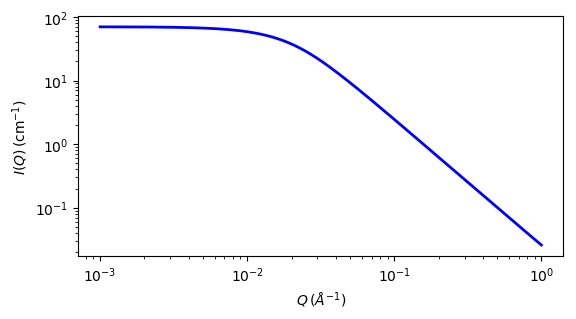mono_gauss_coil
Scattering from monodisperse polymer coils
| Parameter | Description | Units | Default value |
|---|---|---|---|
| scale | Scale factor or Volume fraction | None | 1 |
| background | Source background | cm-1 | 0.001 |
| i_zero | Intensity at q=0 | cm-1 | 70 |
| rg | Radius of gyration | Å | 75 |
The returned value is scaled to units of cm-1 sr-1, absolute scale.
This Debye Gaussian coil model strictly describes the scattering from monodisperse polymer chains in theta solvents or polymer melts, conditions under which the distances between segments follow a Gaussian distribution. Provided the number of segments is large (ie, high molecular weight polymers) the single-chain form factor P(Q) is that described by Debye (1947).
To describe the scattering from polydisperse polymer chains see the poly_gauss_coil model.
Definition
where
Here, \(\phi_\text{poly}\) is the volume fraction of polymer, \(V\) is the volume of a polymer coil, M is the molecular weight of the polymer, \(N_A\) is Avogadro’s Number, \(\delta\) is the bulk density of the polymer, \(\rho_\text{poly}\) is the sld of the polymer, \(\rho\text{solv}\) is the sld of the solvent, and \(R_g\) is the radius of gyration of the polymer coil.
The 2D scattering intensity is calculated in the same way as the 1D, but where the q vector is redefined as

Fig. 109 1D plot corresponding to the default parameters of the model.
Source
mono_gauss_coil.py
\(\ \star\ \) mono_gauss_coil.c
References
- P Debye, J. Phys. Colloid. Chem., 51 (1947) 18.
- R J Roe, Methods of X-Ray and Neutron Scattering in Polymer Science, Oxford University Press, New York (2000).
- http://www.ncnr.nist.gov/staff/hammouda/distance_learning/chapter_28.pdf
Authorship and Verification
- Author:
- Last Modified by:
- Last Reviewed by: